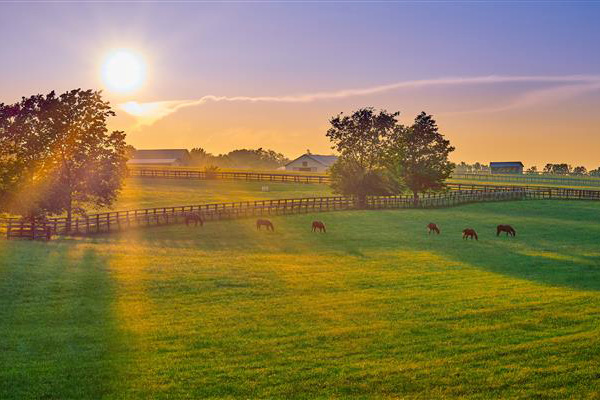 Warmer and wetter conditions in Central Kentucky might increase the presence of some grasses in horse pastures. | Adobe stock
Warmer and wetter conditions in Central Kentucky might increase the presence of some grasses in horse pastures. | Adobe stockHere in Central Kentucky, we are warmer and wetter today than 50 years ago, and these climate trends are predicted to continue.
How do these new climate conditions impact the forage base that supports our equine industry? That is the question our lab posed back in 2008 and received a national grant to examine. We established a manipulative, field experiment elevating temperatures and rainfall on a pasture which we planted in typical Central Kentucky pasture species: Kentucky bluegrass, tall fescue, red and white clover and increasingly common bermudagrass. We used overhead infrared radiant heaters to increase the temperature of the plant canopy by 3oC, day and night, year-round for five consecutive years, and we added +30% of the long-term mean annual rainfall only on wet days, during the growing season, to mimic larger rainfall events on the plots slated for that treatment. We compared the effects of elevated temperature alone, increased rainfall alone and the combination of both treatments to ambient conditions.
We found that warmer conditions significantly increased overall forage production (+19%), in part by stimulating cool-season grass growth earlier in the spring and later into the fall. However, higher temperatures in the summer promoted the growth of warm-season grasses (bermuda and crabgrass) at the expense of traditional cool-season forages (Kentucky bluegrass and tall fescue). Over the five-year period, tall fescue abundance was dramatically reduced (from 40% to 20%) in the warmed treatments compared to ambient controls. Importantly for grazing horses, the tall fescue that remained in the elevated temperature plots was more likely to be endophyte-infected and had significantly higher concentrations of toxic alkaloids such as ergovaline, the putative agent of fescue toxicosis. Endophyte-infected tall fescue plants experiencing warming had 30% higher concentrations of ergovaline than endophyte-infected material grown under ambient conditions, particularly in the fall. The effects of the increased rainfall treatment were less pronounced than that of the temperature response.
Given the significant animal health issues caused by consumption of toxic tall fescue, the observed increase in alkaloid concentrations with warming is a cause for concern. However, the reduction in tall fescue abundance and the increase in other non-toxic, warm-season forage species may mean that fescue toxicity is diluted for grazing animals. The type of warm-season forage species that responds will be important, as annual species – like crabgrass – will die out in the fall and could potentially leave bare soil exposed over winter, an erosion/mud concern. Some perennial and annual warm-season species in our pasture seedbanks are not preferred horse forages (e.g., nimblewill and goosegrass).
Desirable perennial warm-season species, such as bermudagrass, are not present in most pastures in Kentucky at this time, and thus, would need to be planted and would require different management than our cool-season forages. Bermudagrass also turns brown in the winter (goes dormant) which could affect the aesthetics of the landscape. For horse farms interested in maintaining a cool-season grass base, planting novel endophyte tall fescue may be an option, given the hardiness of tall fescue and the non-toxic nature of these endophytes. While fescue and Kentucky bluegrass abundance decreased over time in our experiment, both species remained after five years, indicating they are able to survive even with increased warm-season species competition.
Although this project did not evaluate the effects of drought and unusually low precipitation, such as Central Kentucky is experiencing this year, these conditions would undoubtedly lower forage production, especially in combination with warming, even for warm season dominated pastures.
Editor’s note: This is an excerpt from Equine Disease Quarterly, Vol. 33, Issue 4, funded by underwriters at Lloyd’s, London, brokers, and their Kentucky agents. It was written by Rebecca L. McCulley, PhD, chair and professor in the Department of Plant & Soil Sciences at the University of Kentucky, in Lexington.
